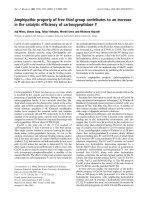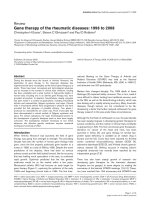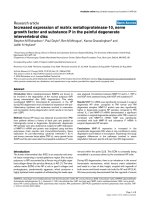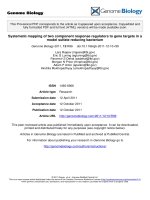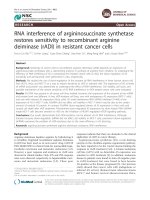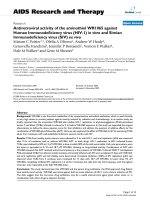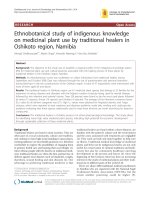Báo cáo y học: "RNA interference of argininosuccinate synthetase restores sensitivity to recombinant arginine deiminase (rADI) in resistant cancer cells" pps
Bạn đang xem bản rút gọn của tài liệu. Xem và tải ngay bản đầy đủ của tài liệu tại đây (798.75 KB, 11 trang )
RESEARC H Open Access
RNA interference of argininosuccinate synthetase
restores sensitivity to recombinant arginine
deiminase (rADI) in resistant cancer cells
Fe-Lin Lin Wu
1,2,3
, Yu-Fen Liang
1
, Yuan-Chen Chang
1
, Hao-Hsin Yo
1
, Ming-Feng Wei
4
and Li-Jiuan Shen
1,2,3*
Abstract
Background: Sensitivity of cancer cells to recombinant arginine deiminase (rADI) depends on expression of
argininosuccinate synthetase (AS), a rate-limiting enzyme in synthesis of arginine from citrulline. To understand the
efficiency of RNA interfering of AS in sensitizing the resistant cancer cells to rADI, the down regulation of AS
transiently and permanently were performed in vitro, respectively.
Methods: We studied the use of down-regulation of this enzyme by RNA interference in three human cancer cell
lines (A375, HeLa, and MCF-7) as a way to restore sensitivity to rADI in resistant cells. The expression of AS at levels
of mRNA and protein was determined to understand the effect of RNA interference. Cell viability, cell cycle, and
possible mechanism of the restore sensitivity of AS RNA interference in rADI treated cancer cells were evaluated.
Results: AS DNA was present in all cancer cell lines studied, however, the expression of this enzyme at the mRNA
and protein level was different. In two rADI-resistant cell lines, one with endogenous AS expression (MCF-7 cells)
and one with induced AS expression (HeLa cells), AS small interference RNA (siRNA) inhibited 37-46% of the
expression of AS in MCF-7 cells. ASsiRNA did not affect cell viability in MCF-7 which may be due to the certain
amount of residual AS protein. In contrast, ASsiRNA down-regulated almost all AS expression in HeLa cells and
caused cell death after rADI treatment. Permanently down-regulated AS expression by short hairpin RNA (shRNA)
made MCF-7 cells become sensitive to rADI via the inhibition of 4E-BP1-regulated mTOR signaling pathway.
Conclusions: Our results demonstrate that rADI-resistance can be altered via AS RNA interference. Although
transient enzyme down-regulation (siRNA) did not affect cell viability in MCF-7 cells, permanent down-regulation
(shRNA) overcame the problem of rADI-resistance due to the more efficiency in AS silencing.
Keywords: argininosuccinate synthetas e arginine deiminase , resistance, RNA interference
Background
Arginine deiminase depletes arginine by hydrolyzing it
to ci trulline. Pegylated recombinant arginine deiminase
(rADI) has been used as an anti-cancer drug (ADI-SS
PEG 20,000 MW) in clinical trials for unresectable hepa-
tocellular carcinoma and metastatic melanoma [1,2].
However, a poor response and resistance to rADI were
observed in clinical studies. Only 47% and 25% response
rates were observed, respectively, in hepatocellular carci-
noma and metastatic melanoma [1,2]. These poor
responses indicate that there are obstacles to the clinical
application of rADI in cancer therapy.
Argininosuccinate synthetase (AS), a rate-limit ing
enzyme in the citrulline-arginine regeneration pathway,
has been reported to be the crucial enzyme limiting the
response to rADI treatment [3,4]. A human melanoma
cell line (A375) with no detectable AS expression was
sensitive to rADI treatment [4]. In addition, melanoma
tissues in patients were found to stain AS-negative prior
to rADI treatment; but were found to have become
AS-positive as the disease progressed [5]. Our previous
study showed that cancer cells with endogenous or
induced AS activity (huma n breast adenocarcinoma
MCF-7 and human cervical adenocarcinoma HeLa,
* Correspondence:
1
School of Pharmacy, College of Medicine, National Taiwan University, Taipei,
Taiwan
Full list of author information is available at the end of the article
Wu et al. Journal of Biomedical Science 2011, 18:25
/>© 2011 Wu et al; licensee BioMed Central Ltd. This is an Open Access article dist ributed under the terms of the Creative Commons
Attribution License ( which permits unrestricted use, distribution, and reproduction in
any medium, provided the origina l work is properly cited.
respectively) were resistant to rADI [6]. Therefore, if AS
confers resistance to rADI, using the RNA silencing
technology to down-regulate AS expression might re-
sensitize the rADI-resistant cancer cells and overcome
the problem of poor response.
RNA silencing, using double-stranded RNA to down-
regulate a specific gene, has been used in canc er
research in vitro and in vivo [7]. Short interfering RNA
(siRNA)andshorthairpinRNA(shRNA)canbothbe
used in RNA silencing technology [8]. However, syn-
thetic 29-mer shRNAs have been reported to have more
potency than 21-mer siRNA [9]. In addition, U6 promo-
ter-exp ressed shRNA, carried by a virus vector, is deliv-
ered to the nucleus and amplified by transcription, while
siRNA, carried by liposomes, is not amplified intrace llu-
larly [10]. Both methods of RNA silencing were used i n
our study to observe the consequenc es to cancer cells
treated with both rADI and RNA interference to AS
expression. Because AS has been reported to play a cru-
cial role in resistance to treatment with rADI in cancer
cells in vitro and in vivo, this study used AS RNA silen-
cing to investigate rADI resistance in cells with endo-
genous or induced AS expression.
Methods
Materials
Recombinant ADI was produced and purified in our
laboratory and had an activity of 11.6 U/mg [11]. The
micro BCA protein assay reagent kit was purchased
from Pierce (Rockford, IL, USA). Lipofectamine™ 2000,
Opti-MEM
®
I Reduced Serum Medium and Super-
Script™ II Reverse Transcriptase for RT-PCR we re pur-
chased from Invitrogen (Carlsbad, CA, USA). All other
chemical reagents were products from Sigma Chemical
Company (St. Louis, MO, USA).
Cell culture
The human breast adenocarcinoma cell line MCF-7,
human cervical adenocarcinoma cell line HeLa, and
human melanoma cell line A375 were purchased from
Bioresource Collection and Research Center (BCRC) in
Taiwan (Hsinchu, Taiwan) and maintained in medium
recommended by ATCC, supplemented with 10% (v/v)
heat-inactivated fetal bovine serum (Invitrogen, Auck-
land, N Z) and 0.5% penicillin-streptomycin (Invitrogen,
Grand Island, NY, USA) in a 5% CO
2
, humid ified incu-
bator at 37°C. All other cell culture reagents were pro-
ducts of Invitrogen (Carlsbad, CA, USA).
Interference of AS expression
siRNA
Small interference RNA for the AS gene and t he nega-
tive control (NC) were designed using a software
BLOCK-iT™ RNAi Designer and were synthesized by
Invitrogen (Carlsbad, CA, USA). The sequences of the
AS gene siRNA (ASsiRNA) and negative control
(NCsiRNA) were 5’ GCUAUGACGUCAUUGCCU Att 3’
(sense), 5’ UAGGCAAUGACGUCAUAGCtt 3’ (anti-
sense) and 5’ GUUUGACUCUCCAAACGGUtt 3’
(sense), 5’ ACCGUUUGGAGAGUCAAACtt 3’ (anti-
sense), respectively. MCF-7 and HeLa cel ls were seeded
respectively in culture plates with a density 30% to 50%
of confluence and incubated in complete medium with-
out penicillin-streptomycin. For transfection, Lipofecta-
mine™ 2000 was used as suggested by the manufacturer
[12]. Western blotting was used to evaluate the effect of
ASsiRNA on AS protein in the 1 to 4 days after the
transfection of siRNA.
shRNA
Lentiviral vectors were produced using pCMV-ΔR8.91,
pMD.G, and pLKO.1-shRNA plasmids that carried
shRNA against AS mRNA (AS-shRNA: CCGGCCA
TCCTTTACCATGCTCATTCTCGAGAATGAGCAT
GGTAAGGATGGATTTTTG) and enhanced green
fluorescent protein (EGFP) as control, respectively. All
plasmids were co-transfected into 293T cells. Viral parti-
cles were harvested from the medium after 40 and 64 hr
post-transduction . MCF-7 c ells were maintained in
RPMI containing 8 μg/mL polybrene and an appropriate
amount of virus with multiplicity of infection (MOI) 2.5.
After 24 hr viral infection, cells were maintained in
RPMI medium with 2 μg/mL puromycin in order to
select lentivirus-transduced cells.
Western blotting
After their respective treatment protocols, cell lysates
were prepared according to previous procedures in our
laboratory [11]. Samples containing equal amounts of
protein were r esolved by 10% SDS-polyacrylamide gel
electrophoresis (SDS-PAGE) under reduced conditions
and transferred to a PVDF membrane (PolyScreen, Bos-
ton, MA, USA). The PVDF membrane was blocked with
PBST(13.7mMNaCl,1mMNa2HPO4,0.2mM
KH2PO4, 0.27 mM KCl, 0.2% Tween-20) contai ning 5%
non-fat milk for 1.5 h and then incubated with primary
antibodyovernight at 4°C. After the immunoblot was
incubated with species-specific horseradish peroxidase
(HRP)-labeled secondary antibody for 1 hr at room tem-
perature, the immunoreact ive protein bands were visua-
lized using the ECL reagents (PerkinElmer Life Science,
Boston, MA) and detected by UVP AutoChemi™ Sys-
tem (UVP, Inc. Upland, CA, USA). The intensity of each
band was quantified using UVP LabWork 4.5 software
(UVP, Inc. Upland, CA, USA). Signals were normalized
according to the expression of the housekeeping
enzyme, GAPDH. Antibodies were as follows: AS (Gu-
Yuan Biotechnology, Taiwan), PARP-1/2 (H-250)(Santa
Cruz Biotechnology, Santa Cruz, CA, USA), a-phospho-
Wu et al. Journal of Biomedical Science 2011, 18:25
/>Page 2 of 11
AMP kinase (Thr172) (Cell Signaling Technology, Dan-
vers, MA, USA), phospho-4E-BP1 (Thr37/46) (Cell Sig-
naling Technology, Danvers, MA), mouse IgG, and
rabbit IgG (Santa Cruz Biotechnology, Santa Cruz, CA,
USA).
PCR for AS DNA and mRNA
AS DNA
DNA was extracted from cultured cells using the
QIAamp DNA Mini Kit (QIAGEN, Hilden, Germany)
and its quality evaluated by agarose gel electrophoresis.
PCR primer s for AS DNA were 5’ ATGGAAGC
TGTCTCTGTA GC3’ (forward) and 5’ CAAGAAGACA
CACTGGAAGG3’ (reverse); and for GAPDH were 5’
ACCCACTCCTCCACCTTTGA3 ’ (forward) and 5’CAT-
ACCAGGAAATGAGCTTGACAA 3’ (reverse). The PCR
profile condition was: 95°C for 5 min, followed by 35
amplification cycles of 95°C for 40 s, 55°C for 30 s, 72°C
for 30 s, and final extension at 72°C for 10 min.
AS mRNA
Total RNA was extracted from cells using REzol™ C&T
kit (PROtech Technologies Inc., Taipei, Taiwan). First-
strand cDNA was synthesized from total RNA using
SuperScript™ II RT (Invitrogen). The RT-PCR profile
condition was: 42°C for 50 min, and then 70°C for 15 min.
Synthesized cDNA was amplified by PCR: the primers of
AS were 5’GAGGATGCCTGAATTCTACA3’ (forward)
and 5’GTTGGTCACCTTCACAGG3’ (reverse); and the
primers of G APDH were same as those used f or DNA.
The PCR profile condition was: 95°C for 5 min, followed
by 20 amplification cycles of 95°C for 40 s, 55°C for 30 s,
72°C for 30 s, and final extension at 72°C for 10 min.
Cell viability assay
Cell cytotoxicity of AS RNA interference and rADI was
evaluated by the MTT (3-[4,5-di methylthiazol-2-yl]-2,5-
diphenyl tetrazolium bromide) method [13]. Cells were
seeded in 24-well culture plates in MEM medium with
supplements and without penicillin-streptomycin. Cells
were transfected with ASsiRNA and NCsiRNA with
Lipofectamine™ 2000 and treated concurrently with
rADI (1 mU/mL). After 1 day-, 2 day-, 3 day-, and 4
day-incubation, 125 μLofMTTstocksolution(5mg/
mL) was added to each well and the plates were incu-
bated f or an additional 2 hr at 37°. After the discard of
the medium containing MTT, the formazan crystal
formed in viable cells was solubilized in isopropanol and
absorbance at 550 nm was measured.
Flow cytometry
Analysis of cell-cycle phase distribu tion in various treat-
ments was evaluated by flow cytometry [14]. After being
treated with drugs, cells were harvested w ith trypsin-
EDTA into centrifuge tubes. Cells w ere centrifuged at
240 g for 10 min to remove supernatant; 70% (V/V)
cold alcohol was ad ded to the cell precipitates to fix the
cells; and the cells were kept at -20°C. Cells were labeled
with propidium iodide (PI) and measured by flow cyto-
metry FACScan FL2 channel and CellQuest program
(Becton Dickinson, San Jose, CA, USA).
Statistical analysis
All values are mean ± SD. Significant difference was
evaluated by ANOVA, followed by the Bonferoni modi-
fied t-test. Values of p < 0.05 were con sidered to be sta-
tistically significant.
Results
Effect of rADI on AS expression in cancer cell lines
DNA for the AS gene was observed in each of the 3 dif-
ferent human cancer cell lines, HeLa, MCF-7, and A375,
used in this study (Figure 1a). Endogenous AS mRNA
was detected clear ly in MCF-7 cells only when the cells
were cultured in the absence of rADI treatment. When
cells in the three cell lines were treated with rADI, an
increase in AS mRNA (induced AS expression) was seen
in HeLa cells, but was not o bvious in MCF-7 and A375
cells (Figure 1b). The levels of AS mRNA found in
the cells corresponded to the levels of AS protein
(Figure 1c). Endogenous A S protein was low in HeLa
cells, but induced AS prote in was observed clearly in
the cells. In MCF-7 cells, endogenous AS protein
expression was abundant in the absence of rADI treat-
ment and there was no significant increase in AS
expression after these cells were treated with rADI.
Expression of AS protein was not detected in A375 cells
with or without rADI treatment.
Down regulation of AS expression by siRNA
AS expression
When cells were treated with rADI for 4 days, significant
amounts of induced and endogenous AS protein were
expressed in HeLa an d MCF-7 cells (Figures. 2a, Lane 6
and 2b, Lane 7). After ASsiRNA had been transfected into
HeLa and MCF-7 cells for 4 days, down-regulation of AS
proteins level was seen in both cell types (Figures 2a, Lane
3 and 2b, Lane 3), but the residual datable amount of AS
protein was observed in MCF-7 cells. In contrast, negative
control siRNA (NCsiRNA) did not down-regulate AS
protein expression in HeLa and MCF-7 cells in the
absence or in the presence of rADI (Figure 2a, Lane 4 and
5 and Figure 2b, Lane 5 and 6). AS protein expression in
HeLa cells treated with rADI was induced 5.6 ± 2.2 fold
(Figure 2a, Lane 1 vs. Figure 2a, Lane 6) that of control
without rADI trea tment, wh en normali zed by GAPDH
expression (p < 0.001). When HeLa cells were treated with
ASsiRNA/rADI for 4 days, there were no viable cells in
the culture plate for Western blotting. In contrast, when
Wu et al. Journal of Biomedical Science 2011, 18:25
/>Page 3 of 11
cells were treated NCsiRNA/rADI for 4 days, the cells
were viable and the expression of induced AS protein was
not significantly different from that seen in rADI treat-
ment alone.
The induction of AS protein expression by rADI treat-
ment, 1.25-fold of control (p > 0.05), was not statistically
significant in MCF-7 cells. A SsiRNA significantly inhib-
ited the AS protein expression in MCF-7 cells without
and with rADI, to 37% and 46% of each control, respec-
tively. (p < 0.001). There was no effect of lipofectamine
and NCsiRNA on AS protein expression in MCF -7 cells
in any treatment protocol (p > 0.05).
Cell viability and cell cycle
To observe the effect of the combination of ASsiRNA
and rADI i n HeLa and MCF-7 cells, cell viability and
cell cycle were analyzed by MTT and flow cytometry,
respectively. The results of the cell viability (Figure 3)
show that only the combination of ASsiRNA and rADI
(Figure 3a) significantly inhibited proliferation and survi-
val in HeLa cells. Cell viability was reduced to 90.1 ±
5.1%, 64.9 ± 0.1%, 13.2 ± 1.5%, and 7.7 ± 0.2% of the
control after 1, 2, 3, and 4 days of ASsiRNA/rADI treat-
ment in HeLa cells. This phenomenon was only
observed in HeLa cells with ASsiRNA/rADI treatment,
(a) AS DNA
HeLa
MCF-7
A375
AS
GAPDH
(b) AS mRNA
HeLa
MCF-7
A375
rADI
-
+
-
+
-
+
AS
GAPDH
(c) AS protein
HeLa
MCF-7
A375
rADI
-
+
-
+
-
+
AS
GAPDH
Figure 1 AS DNA, mRNA, and protein expression in HeLa, MCF-7, and A375 cells. (a) DAN was extracted from cells, and AS DNA was
further amplified by PCR using specific primers. (b and c) Cells were treated with 1 mU/mL of rADI or PBS (as control) for 4 days, and total RNA
(b) and protein (c) were extracted. PCR and Western blot were used for evaluation of AS mRNA and protein expression, respectively.
Wu et al. Journal of Biomedical Science 2011, 18:25
/>Page 4 of 11
and not with NCsiRNA/rADI and the other treatments
used. In contrast, cell viability in MCF-7 cells was not
affected by ASsiRNA/rADI treatment even though AS
protein was down-regulated (Figure 3b).
The combination of ASsiRNA/rADI influenced
the cell cycle in HeLa cells, but not in MCF-7 cells
(Figure 4). After 4 days of ASsiRNA transfection a nd
rADI treatment, the percentage of subG1 phase cells
increased from 10.7% to 63.4% in HeLa cells.
Down regulation AS expression by shRNA
ASsiRNA did not e ffectively dow n-regulate AS protein
expression in MCF-7 cells (Figure 2b). However, shRNA
interference with AS protein expression was achieved in
MCF-7 cells, using a lentiviral vector to deliver ASshRNA.
AS expression
Figure 5 shows the results of ASshRNA on AS mRNA
and protein expression in MCF-7 cells at the 15th
passage after transduction. Compared to the controls
(untransduced and EGFP-transduced MCF-7 cells),
ASshRNA effectively down-regulated AS mRNA and
protein expression due to its specific targeting of AS
mRNA. Similar results were observed from the 5th to
the 25th passages after puromycin selection.
Cell viability and cell cycle
Cell viability of untransduced, EGFP-transduced and
ASshRNA-transduced MCF-7 cells (control) and with
rADI treatment is shown in Figure 6. Cell viability of
the untransduced MCF-7 cells after 1 to 4 days treat-
ment with rADI was in the range of 100% to 73% com-
pared to cells without rADI treatment. Similarly, the cell
viability of EGFP-transduced MCF-7 cells after 1 to 4
days rADI treatment was 89% to 77% of the controls, a
decrease that failed to reach statistical significance. In
contrast, the cell viability of ASshRNA-transduced cells
under rADI treatment was significantly decreased to
(a) HeLa
1 2 3 4 5 6
AS
GAPDH
lipofectamine
-
+
+
+
+-
ASsiRNA
-
-
+
-
NCsiRNA
-
-
-
+
+-
rADI
-
-
-
-
++
(b) MCF-7
1 2 3 4 5 6 7
AS
GAPDH
lipofectamine
-
+
+
+
+
+
-
ASsiRNA
-
-
+
+
-
-
-
NCsiRNA
-
-
-
-
+
+
-
rADI
-
-
-
+
-
+
+
Figure 2 Effect of ASsiRNA and rADI on AS protein expression in HeLa and MCF-7 Cells. Cells were seede d in 6-well plat es and
transfected with ASsiRNA or NCsiRNA by Lipofectamine™ 2000, respectively. After 4-day treatments with different additives, AS protein
expression was analyzed both in HeLa (a) and MCF-7 (b) cells. Lipofectamine, ASsiRNA, NCsiRNA, 1 mU/mL of rADI, or combinations of these
substances were used. The result of ASsiRNA and rADI in HeLa cells was not present in Figure 2a because of no viable cells after the treatment
for western blotting.
Wu et al. Journal of Biomedical Science 2011, 18:25
/>Page 5 of 11
70%, 42%, and 23% of co ntrol values on the 1st, 2nd,
and 4th days after treatment (p < 0.001).
The effect of rADI on the cell cycle in untransduced,
EGFP-transduced, and ASshRNA-transduced MCF-7 cells
is shown in Figure 7. The percentages of untransduced
MCF-7 cells (the control cells) in the G0/G1 and G2/M
phases were 31.9% and 59.3%, respectively, in the absence
of rADI treatment (Figure 7a). In addition, fewer than 5%
and 10% were in the subG1 and S phases, r espectively.
A similar cell cycle distribution was seen in untransduced
(
a
)
HeLa
(
b) MCF-7
*
***
***
***
Figure 3 Effect of ASsiRNA and rADI on viability of HeLa and MCF-7 cells. Cells were seeded in 24-well plates and treated with different
conditions for 4 days, and cell viability was evaluated by MTT assay. These conditions included PBS as control, lipofectamine, ASsiRNA, NCsiRNA,
1 mU/mL of rADI, or combinations of them as shown in the figure. Each group was compared to control on the same day, and the error bars
represent standard deviation (n = 6). *p < 0.05, ***p < 0.001.
Wu et al. Journal of Biomedical Science 2011, 18:25
/>Page 6 of 11
MCF-7 cells in the presence of rADI treatment. The cell
cycle patterns of EGFP-transduced MCF-7 cells with and
without rADI treatment were also similar to that of the
controls (Figure 7b). Although the cell cycle of ASshRNA-
transduced MCF-7 cells in the absence of rADI was simi-
lar to the controls, significant changes were seen when
these cells were treated with rADI. The subG1 phase per-
centage was increased to 52.7%, and the G0/G1 and G2/M
phase percentages were dec reased to 12.5% and 30.0%,
respectively (Figure 7c).
Mechanism of cell death by the rADI and AS protein
silencing
To understand the mechanism of rADI causing apo pto-
sis on AS silencing MCF-7 cells, proteins involving in
different pathways of apoptosis were analyzed by wes-
tern blotting in MCF-7 c ells and ASshRNA-transduced
MCF-7 c ells with rADI (Figure 8). After the treatment
of rADI, the decreased amount of phospho-4E-BP1 pro-
tein expression was observed in ASshRNA-transduced
MCF-7 cells, but not in MCF-7 cells. Whereas, rADI
HeLa
MCF-7
Control
rADI only
ASsiRNA/rADI
Figure 4 Effect of ASsiRNA and rADI on cell-cycle phase distribution in HeLa and MCF-7 cells. Cells were seeded in 6-well plates and
collected after treating with PBS as control, 1 mU/mL of rADI, or the combination of ASsiRNA transfection and rADI for 4 days, respectively. The
cell collections were stained by propidium iodide and the cell-cycle phase distribution examined by flow cytometry.
Wu et al. Journal of Biomedical Science 2011, 18:25
/>Page 7 of 11
caused similar effect on the levels of PARP and phos-
phor-AMP kinase in MCF-7 cells and ASshRNA-
transduced MCF-7 cells (Figure 8).
Discussion
In this study, the regulation of AS activity by rADI and
AS RNA interference was studied in 3 human cancer
cell lines. AS DNA was present in all 3 cell lines, but
AS expression in mRNA and protein varied. AS expr es-
sion was undetectable in A375 cells, causing these cells
to be sensitive t o rADI treatment. According to a pre-
vious study [15], the mechanism responsible for the
absence of AS expression in cancer ce lls in spite of the
presence of A S DNA might be due to aberrant promo-
ter CpG methylation. The amount of AS protein expres-
sion corresponded to the amount of AS mRNA in our
results, a finding consistent with other reports [4,15,16].
The AS regulation could be mainly at translational level.
In addition, in this report, we also found that induction
of AS protein expression by rADI was seen in HeLa
cells, causing resistance to rADI treatment in this cell
type that has undetectable endogenous AS mRNA.
Cells from two cell lines, HeLa and MCF-7, survived
after down-regulation of AS expression only when cells
were cultured in complete medium containing arginine.
This indicates that AS is not an essential gene in cancer
cells w hen t h e supply of arginine from extracellular sourc es
is ade quate. However, when cells were tre ated with r ADI in
the absence of extracellular arginine, the AS gene becomes
essential in the AS down-regulated cells. Arginine depriva-
tion in normal cells can block the restriction-point transi-
tion, resulting in G1 arrest, a condition in which viability is
maintained for extended periods [17], but the same condi-
tion in cancer cells leads to cell death on a massive sca le
within few days [18,19]. Therefore the combination of AS
RNA interfere nce and rADI may have selective toxicity
toward cancer cells. In our study, we have demonstrated
that regulation of AS expression can be a strategy to solve
the problem of rADI-resistance in cancer cells. However,
further experiments in the targeting of AS RNA interfer-
ence to tumor cells will be necessary before future clinical
application o f this stra tegy i s possible.
In our experiments on AS RNA interference, we
found ASsiRNA to reduce AS protein expression more
efficiently in HeLa cells than in MCF-7 cells (Figure 2).
In HeLa cells, but not in MCF-7 cells, AS protein
expression was reduced to an undetectable range by
ASsiR NA (Figure 3a, L ane 3). We used siRNA mediated
by liposomes to knockdown AS gene expression in the
rADI-resistant HeLa tumor cell line and then examined
the effect of rADI treatment. Introduction of siRNA by
this method converted t hese cells to rADI sensitivity
(Figure 3). The HeLa c ells thus treated showed DNA
damage and a significant increase in the cells in the
(a) AS mRNA
Unt
EGFP
ASshRNA
AS
GAPDH
(b) AS protein
Unt
EGFP
ASshRNA
AS
GAPDH
Figure 5 AS mRNA and protein expres sion in ASshRNA-
tranduced MCF-7 cells. MCF-7 was transduced with ASshRNA
delivered by lentiviruses for generation of stable AS-shRNA
expression cell lines. After 15 passages of subculture, total RNA and
protein were extracted from the cells. AS mRNA level was evaluated
by PCR (a) and endogenous AS protein expression was determined
by Western blotting (b). Unt represents untransduced MCF-7; EGFP:
EGFP-transduced MCF-7; and ASshRNA: ASshRNA-transduced MCF-7.
Figure 6 Effect of ASshRNA interference and rADI on cell
viability in MCF-7 cells. Cells were seeded in 24-well plates and
treated with PBS (control) or with 1 mU/mL of rADI for 4 days. The
MTT assay was performed to evaluate cell viability. The cells
included untransduced MCF-7 (Untransduced), EGFP-transduced
MCF-7 (EGFP), and ASshRNA- transduced MCF-7 (ASshRNA). Each
group with rADI-treatment was compared to each type of cells in
the absence of rADI as control on the same day. Error bars
represent standard deviation (n = 6). ***p < 0.001.
Wu et al. Journal of Biomedical Science 2011, 18:25
/>Page 8 of 11
subG1 phase of cell cycle regulation (Figure 4). This
observation shows that the cell death pathway was fol-
lowed by apopt osis. This result is similar to so me
reports indicating the ADI that inhibits proliferation of
cells by inducing cell cycle arrest and apoptosis [20-22].
Transient AS knockdown with rADI treatment led HeLa
cells to die but did not affect the survival of MCF-7 cells
even significantly inhibited the AS protein expression to
40% of control. (Figures 3 a nd 2b). We used ASshRNA
carried by lentivirus to transduce MCF-7 cells in order to
establish long-term AS gene knockdown and the AS pro-
tein expression was in an undetectable level (Figure 5b).
When stable AS gene-silenced MCF-7 cells were treated
with rADI, cells entered the apoptosis pathway (Figure 7).
According to the residual amount of AS protein expres-
sion (Figures 2b and 5b), ASshRNA was more efficient
than ASsiRNA in the down-regulation of AS expression
in MCF-7 cells. Previous reports have shown synthetic
29-mer shRNAs to be more potent inducers of RNA inter-
ference than siRNAs [9,23]. Whe n sh RNAs delive ry i s
mediated by lentivirus vectors, these RNAs can be deliv-
ered into the nucleus and be amplified by RNA polymer-
ase III [24]. In contrast, siRNAs delivered by liposomes are
only expressed in the cytosol and therefore cannot be
amplified. However, we were unable to explain why the
two cell lines, HeLa and MCF-7, respond to siRNA in a
different manner. We surmise that differences in the
amount of AS protein expressed when protein expression
is endogenous protein or induced protein, or some other
mechanism, may influence the efficiency of siRNA.
After rADI treatment, the level of phospho-4E-BP1 is
decreased in ASshRNA-transduced MCF-7 cells other
than in MCF-7 cells (Figure 8). 4E-BP1 plays a cr ucial
role in the mammalian target of rapamycin (mTOR)-
mediated translational signaling pathway [25]. A large
body of evidence shows that the blockade of mTOR
Control
rADI
(a) Unt
(b) EGFP
(c)
ASshRNA
Figure 7 Effect of ASshRNA interference and rADI on cell-cycle phase distribution in MCF-7. Cells were seeded in 6-well plates and collected
after treatment with PBS (control) or with rADI for 4 days. Collections then were stained with propidium iodide and the cell-cycle phase distribution
examined via flow cytometry. Unt represents untransduced MCF-7; EGFP: EGFP-transduced MCF-7; and ASshRNA: ASshRNA transduced-MCF-7.
Wu et al. Journal of Biomedical Science 2011, 18:25
/>Page 9 of 11
pathways contributes to several anticancer effects,
including anti-proliferation and apoptotic cell death
[26]. Besides, mTOR pathways are controlled by numer -
ous upstream regulators, such as AMPK and phosphoi-
nositol-3 kinase. The data in the present work support
that rADI treatment induces antica ncer activity through
the inhibition of mTOR-mediated signals but in an
AMPK-independent fashion in ASshRNA-transduced
MCF-7 cells. However, rADI-treated MCF -7 cells a nd
ASshRNA-transduced MCF-7 cells did not show PARP
cleavage, a marker of caspase-dependent apoptosis. It
may indicate rADI treatment causes antiproliferation
and c aspase -independent apoptosis other than caspase-
dependent apoptosis. Furthermore, it was reported that
the effect of rADI on autophagy was observed in
CWR22Rv1 cells expressing undetectable AS protein
level, but not in LNCaP cells which express AS protein
[22]. We did not observe similar effect of rADI on
autophagy in both MCF-cells and ASshRNA-transduced
MCF-7 cells by using autophagy inhibitor chloroquine
(data not shown). It may be explained by the residual
detectable amount of AS expression in ASshRNA-
transduced MCF-7 cells. However, autophagy is not nor-
mally occurred in a wide variety of cells. Accordingly,
the different cell lines may also explain the discrepancy.
Conclusions
De novo arginine synthesis via the ci trulline-arginine
regeneration pathway is the determining factor in the
success or failure of rADI treatment in cancer [27,28].
Some cancer cells, such as the A375 melanoma cells
tested in this study, lack the ability to synthesize argi-
nine de novo via AS and AL [15,29-31] and therefore
are sensitive to rADI treatment. However, we found
from our results that two p rototypes f or cancer cells,
HeLa and MCF-7, were resistant to rADI treatment.
Cell types similar to HeLa cells have low endogenous
AS protein e xpression but conspicuously induced
AS protein expression after rADI treatment. Cell types
likeMCF-7cellshaveabundantendogenousASprotein
expression and do not show visibly induced AS
protein expression after rADI treatment. We have also
demonstrated that AS down-regulation can change
rADI-resistant into rADI-sensitive canc er cells. The
mechanism o f rADI on anticancer ef fect in ASshRNA-
transduced MCF-7 c ells may invo lve the inhibition of
4E-BP1-regulated mTOR signaling pathways. Different
efficiency in AS down-regula tion by siRNA or shRNA
was observe d in HeLa and MCF-7 cells. These findings
will be important to treatment outcome when rADI is
introduced into cancer therapy.
MCF-7
-
+
-
+
ASshRNA MCF-7
rADI
PARP
p4EBP1
GAPDH
p
AMPK
AS
116 kDa
89 kDa
Figure 8 Effect of rAD I on proteins expression involving in pathways of apoptosis. MCF-7 and ASshRNA-transduced MCF-7 cells were
collected after treatment with PBS (control) or rADI for 1 day, respectively. Various proteins, PARP, a-phospho-AMP kinase (pAMPK), phospho-4E-
BP1 (p4EBP1), AS, and GAPDH were determined by Western blotting.
Wu et al. Journal of Biomedical Science 2011, 18:25
/>Page 10 of 11
Acknowledgements
This work was supported by grants (NSC 97-2320-B-002-015-MY3 and
DOH99-TD-B-111-001) from the National Science Council, Taiwan and the
Department of Health, Taiwan, respectively. We thank the National RNAi
Core Facility in the Institute of Molecular Biology/Genomic Research Center,
Academic Sinica, for providing RNAi reagents, supported by the National
Research Program for Genomic Medicine Grants of NSC (NSC 97-3112-B-001-
016). We are grateful to Drs. Jih-Hwa Guh and Li-Chin Hsu (School of
Pharmacy, College of Medicine, National Taiwan University, Taipei, Taiwan)
for their helpful discussion.
Author details
1
School of Pharmacy, College of Medicine, National Taiwan University, Taipei,
Taiwan.
2
Graduate Institute of Clinical Pharmacy, College of Medicine,
National Taiwan University, Taipei, Taiwan.
3
Department of Pharmacy,
National Taiwan University Hospital, Taipei, Taiwan.
4
National Center of
Excellence for Clinical Trial and Research Center, National Taiwan University
Hospital, Taipei, Taiwan.
Authors’ contributions
FLW and LJS conceived of the study, and participate in its design and
coordination and helped to draft the manuscript. YFL and YCC carried out
the AS shRNA and siRNA studies, respectively. HHY prepared and
recombinant protein arginine deiminase for studies. MFW studied the
mechanism of apoptosis by the treatment of ASshRNA/rADI in MCF-7 cells.
All authors read and approved the final manuscript.
Competing interests
The authors declare that they have no competing interests.
Received: 6 April 2010 Accepted: 1 April 2011 Published: 1 April 2011
References
1. Izzo F, Marra P, Beneduce G, Castello G, Vallone P, De Rosa V, Cremona F,
Ensor CM, Holtsberg FW, Bomalaski JS, et al: Pegylated arginine deiminase
treatment of patients with unresectable hepatocellular carcinoma:
results from phase I/II studies. J Clin Oncol 2004, 22:1815-1822.
2. Ascierto PA, Scala S, Castello G, Daponte A, Simeone E, Ottaiano A,
Beneduce G, De Rosa V, Izzo F, Melucci MT, et al: Pegylated arginine
deiminase treatment of patients with metastatic melanoma: results from
phase I and II studies. J Clin Oncol 2005, 23:7660-7668.
3. Shen LJ, Beloussow K, Shen WC: Modulation of arginine metabolic
pathways as the potential anti-tumor mechanism of recombinant
arginine deiminase. Cancer Lett 2006, 231:30-35.
4. Ensor CM, Holtsberg FW, Bomalaski JS, Clark MA: Pegylated arginine
deiminase (ADI-SS PEG20,000 mw) inhibits human melanomas and
hepatocellular carcinomas in vitro and in vivo. Cancer Res 2002,
62:5443-5450.
5. Feun L, You M, Wu CJ, Kuo MT, Wangpaichitr M, Spector S, Savaraj N:
Arginine deprivation as a targeted therapy for cancer. Curr Pharm Des
2008, 14:1049-1057.
6. Shen LJ, Lin WC, Beloussow K, Shen WC: Resistance to the anti-
proliferative activity of recombinant arginine deiminase in cell culture
correlates with the endogenous enzyme, argininosuccinate synthetase.
Cancer Lett 2003, 191:165-170.
7. Leung RK, Whittaker PA: RNA interference: from gene silencing to gene-
specific therapeutics. Pharmacol Ther 2005, 107:222-239.
8. Yang M, Mattes J: Discovery, biology and therapeutic potential of RNA
interference, microRNA and antagomirs. Pharmacol Ther 2008, 117:94-104.
9. Siolas D, Lerner C, Burchard J, Ge W, Linsley PS, Paddison PJ, Hannon GJ,
Cleary MA: Synthetic shRNAs as potent RNAi triggers. Nat Biotechnol 2005,
23:227-231.
10. Tuschl T: Expanding small RNA interference. Nat Biotechnol 2002,
20:446-448.
11. Yu HH, Wu FL, Lin SE, Shen LJ: Recombinant arginine deiminase reduces
inducible nitric oxide synthase iNOS-mediated neurotoxicity in a
coculture of neurons and microglia. J Neurosci Res 2008, 86:2963-2972.
12. Gitlin L, Karelsky S, Andino R: Short interfering RNA confers intracellular
antiviral immunity in human cells. Nature 2002, 418:430-434.
13. Morgan DM: Tetrazolium (MTT) assay for cellular viability and activity.
Methods Mol Biol 1998, 79:179-183.
14. Nicholson LJ, Smith PR, Hiller L, Szlosarek PW, Kimberley C, Sehouli J,
Koensgen D, Mustea A, Schmid P, Crook T: Epigenetic silencing of
argininosuccinate synthetase confers resistance to platinum-induced cell
death but collateral sensitivity to arginine auxotrophy in ovarian cancer.
Int J Cancer 2009, 125:1454-1463.
15. Szlosarek PW, Klabatsa A, Pallaska A, Sheaff M, Smith P, Crook T,
Grimshaw MJ, Steele JP, Rudd RM, Balkwill FR, Fennell DA: In vivo loss of
expression of argininosuccinate synthetase in malignant pleural
mesothelioma is a biomarker for susceptibility to arginine depletion. Clin
Cancer Res 2006, 12:7126-7131.
16. Savaraj N: The Relationship of Arginine Deprivation, Argininosuccinate
Synthetase and Cell Death in Melanoma. Drug Target Insights 2007,
2:119-128.
17. Lamb J, Wheatley DN: Single amino acid (arginine) deprivation induces
G1 arrest associated with inhibition of cdk4 expression in cultured
human diploid fibroblasts. Exp Cell Res 2000, 255:238-249.
18. Philip R, Campbell E, Wheatley DN: Arginine deprivation, growth
inhibition and tumour cell death: 2. Enzymatic degradation of arginine
in normal and malignant cell cultures. Br J Cancer 2003, 88:613-623.
19. Scott L, Lamb J, Smith S, Wheatley DN: Single amino acid (arginine)
deprivation: rapid and selective death of cultured transformed and
malignant cells. Br J Cancer 2000, 83:800-810.
20. Gong H, Zolzer F, von Recklinghausen G, Rossler J, Breit S, Havers W,
Fotsis T, Schweigerer L: Arginine deiminase inhibits cell proliferation by
arresting cell cycle and inducing apoptosis. Biochem Biophys Res Commun
1999, 261:10-14.
21. Gong H, Zolzer F, von Recklinghausen G, Havers W, Schweigerer L: Arginine
deiminase inhibits proliferation of human leukemia cells more potently
than asparaginase by inducing cell cycle arrest and apoptosis. Leukemia
2000, 14:826-829.
22. Kim RH, Coates JM, Bowles TL, McNerney GP, Sutcliffe J, Jung JU, Gandour-
Edwards R, Chuang FY, Bold RJ, Kung HJ: Arginine deiminase as a novel
therapy for prostate cancer induces autophagy and caspase-
independent apoptosis. Cancer Res 2009, 69:700-708.
23. Kim DH, Behlke MA, Rose SD, Chang MS, Choi S, Rossi JJ: Synthetic dsRNA
Dicer substrates enhance RNAi potency and efficacy. Nat Biotechnol 2005,
23:222-226.
24. Mittal V: Improving the efficiency of RNA interference in mammals. Nat
Rev Genet 2004, 5:355-365.
25. Proud CG: Regulation of mammalian translation factors by nutrients. Eur
J Biochem 2002, 269:5338-5349.
26. Baldo P, Cecco S, Giacomin E, Lazzarini R, Ros B, Marastoni S: mTOR
pathway and mTOR inhibitors as agents for cancer therapy. Curr Cancer
Drug Targets 2008, 8:647-665.
27. Wheatley DN, Kilfeather R, Stitt A, Campbell E: Integrity and stability of the
citrulline-arginine pathway in normal and tumour cell lines. Cancer Lett
2005,
227:141-152.
28. Shen LJ, Shen WC: Drug evaluation: ADI-PEG-20–a PEGylated arginine
deiminase for arginine-auxotrophic cancers. Curr Opin Mol Ther 2006,
8:240-248.
29. Dillon BJ, Prieto VG, Curley SA, Ensor CM, Holtsberg FW, Bomalaski JS,
Clark MA: Incidence and distribution of argininosuccinate synthetase
deficiency in human cancers: a method for identifying cancers sensitive
to arginine deprivation. Cancer 2004, 100:826-833.
30. Yoon CY, Shim YJ, Kim EH, Lee JH, Won NH, Kim JH, Park IS, Yoon DK,
Min BH: Renal cell carcinoma does not express argininosuccinate
synthetase and is highly sensitive to arginine deprivation via arginine
deiminase. Int J Cancer 2007, 120:897-905.
31. Bowles TL, Kim R, Galante J, Parsons CM, Virudachalam S, Kung HJ, Bold RJ:
Pancreatic cancer cell lines deficient in argininosuccinate synthetase are
sensitive to arginine deprivation by arginine deiminase. Int J Cancer
2008, 123:1950-1955.
doi:10.1186/1423-0127-18-25
Cite this article as: Wu et al.: RNA interference of argininosuccinate
synthetase restores sensitivity to recombinant arginine deiminase (rADI)
in resistant cancer cells. Journal of Biomedical Science 2011 18:25.
Wu et al. Journal of Biomedical Science 2011, 18:25
/>Page 11 of 11

